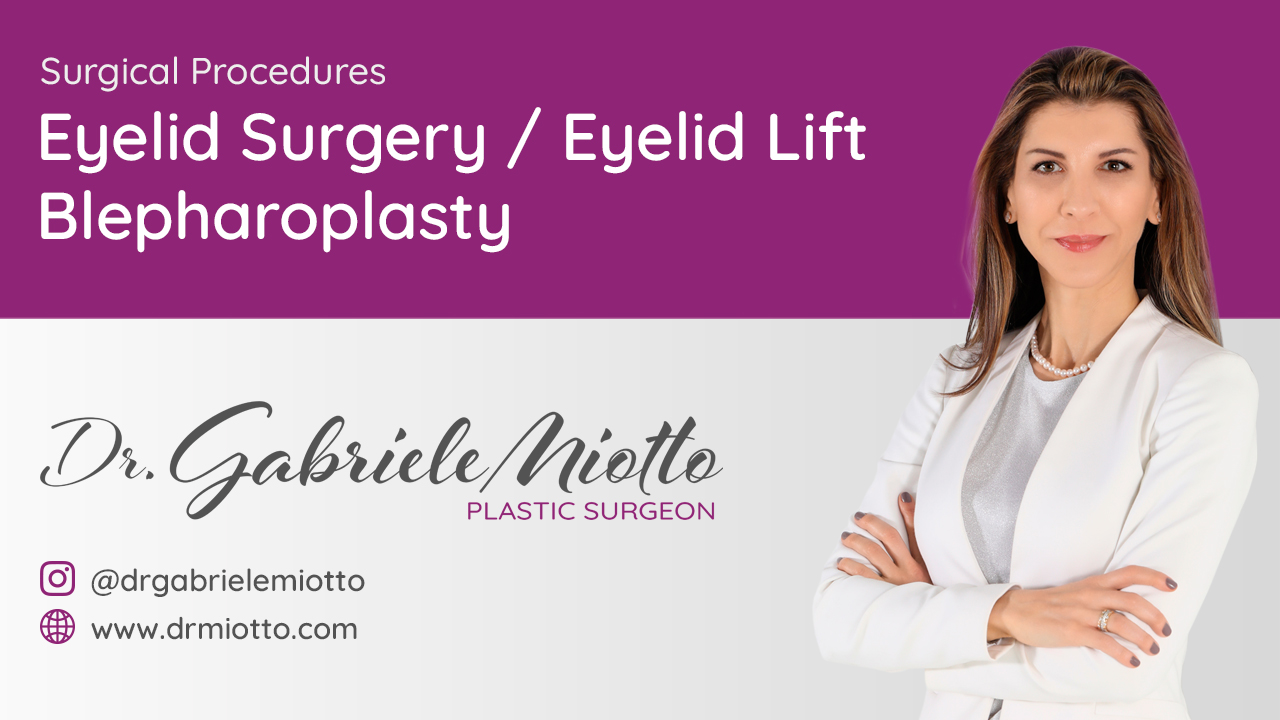The eyelids frame and protect the eyes, bringing beauty and expression to the face. The eye region (periocular area) plays a crucial role in our daily interactions with each other and aging in this area can be very noticeable. As we get older, the eyelid tissues become thinner and the skin loses elasticity contributing to a “tired” or aged appearance. It is also common to notice more puffiness around the eyes and visible dark circles and wrinkles.
Aesthetic eyelid surgery, known as blepharoplasty or eyelid lift, is a common procedure used to rejuvenate the periocular area and treat excess skin, puffiness and dark circles, with the purpose of make the appearance of the eyes more vibrant and less tired. During a blepharoplasty, the surgeon removes the excess skin, loose muscle and fat from the eyelids and tightens the tissues for a rejuvenated look. If the eyelids are sunken or hollow, fat grafting can be added to the eyelids for a great rejuvenating tool. Modern eyelid surgery includes not only removing excessive tissue but also adding tissues, such as the patient’s own fat to restore the youthful anatomy. There is no cookie cutter procedure when we talk about aesthetic surgery, specially the eyelids. Individuality, patient’s race, facial shape, aging patters, they all count when making a surgical plan.
A blepharoplasty can be done for the upper and lower eyelids depending on the individual needs. Small incisions are placed inside the eyelids (in the conjunctiva – called transconjunctival blepharoplasty) or in the natural creases of the lids where the scar can be hidden (skin pinch blepharoplasty or skin-muscle blepharoplasty). Blepharoplasty is an outpatient surgery done under local anesthesia and sedation or under general anesthesia. After the procedure, there will be visible fine skin sutures in the incisions (for skin pinch or skin muscle blepharoplasty) or no sutures (for transconjunctival blepharoplasty) .
Eyelid surgery is not a painful procedure, but mild discomfort around the eyes is expected. Bruising and swelling are usually the cause of the discomfort. However, it can be treated with preoperative and postoperative medication and supplementation, ice and anti-inflammatories. Swelling can be minimal or more intense depending on how many procedures need to be done in surgery to make the results the most beautiful and natural possible. Frequent combined procedures with a blepharoplasty or eyelid lift include: fat grafting to the eyelids or to the face, endo browlift or lateral brow lift, laser resurfacing or resurfacing with a chemical peel to treat the skin aging, facelift or neck lift…there are many options for us to use to achieve the best results.
Sutures are removed between 5-7 days after the blepharoplasty. Expect at least two weeks for committing to major social events as residual bruising and more visible swelling can be prominent during the first 2 weeks after surgery. We are all different, so it is hard to predict who will get more or less swelling and bruising. Therefore, we usually recommended that you perform a blepharoplasty 2-4 weeks before any major social events.
There are non-surgical options to a blepharoplasty. For patients with hollowed eyelids, temples or deep dark circles we can use hyaluronic acid fillers or your he patient’s own fat to rejuvenate these areas. Aging causes facial deflation or loss of fatty tissue around the eyes which contributes tremendously to a tired and aged appearance.
Hyaluronic acid fillers are recommended as temporary but effective nonsurgical options and can be repeated every year or as needed. Fat is a more permanent solution but is partially reabsorbed and more than one injection session may be needed.
Hyaluronic acid injections are done in the office using topical anesthetic. Fat grafting requires the use of local anesthesia for numbing of the fat harvesting area. Fat can be harvested from any fatty deposit in the body, it is prepared as microfat and injected in depleted periocular areas – it is the patient’s own natural filler. Expect some swelling and bruising for a few days after any injection of hyaluronic acid fillers or fat.
Our goal is to provide individual beautiful and natural results. Always!
General preoperative recommendations for blepharoplasty / eyelid lift surgery:
What to avoid before surgery:
- DO NOT take any aspirin for 7-10 days before your scheduled procedure. Do not take NSAIDS (Aleve, Motrin, Ibuprofen) for 5 days before surgery. You may take Tylenol (Acetaminophen) if needed for aches or pains. Please contact the office at if you have any questions about any medications that you are taking or if you are prescribed aspirin by your cardiologist or Primary Care Provider (PCP).
- Discontinue Vitamin E 10 days before surgery.
- Avoid the following herbal supplements for 10 days before surgery: Echinacea, Ephedra / Phentermine (used for weight loss), Feverfew, Fish Oils, Garlic, Ginkgo Biloba, Goldenseal, Kava-Kava, Licorice, Saw Palmetto, St. John’s Wort and Valerian.
- Stop Smoking. The harmful effects of smoking can cause tissue death, infection, and open wounds. It also makes you age faster!
- Alcohol can promote swelling of the surgical area and it is best to avoid alcohol intake for at least one week before surgery.
What to take before surgery:
- Vitamin C may aid in preventing bruising and speeding healing. Consider taking 2000 mg per day 1 week before surgery (this can be split into two 1000 mg doses per day).
- The supplement HealFast® may speed up recovery after surgery. If you choose to take these supplements, please begin taking them five days before surgery as instructed on the packaging. They can be purchased online at healfastproducts.com or on websites like Amazon.
- Before a chemical peel or laser treatment, Dr Miotto will instruct you to begin using tretinoin (retin-a) and hydroquinone two weeks before your procedure to speed up the healing process. We carry these products at our Spa for your convenience.
General postoperative recommendations after blepharoplasty / eyelid surgery:
- You MUST have a responsible adult to transport you home and stay with you for a full twenty-four hours after your surgery. If general anesthesia is used, the medications used during the procedure directly affect the nervous system, and for your safety, we will not allow you to drive or be home alone immediately after surgery.
- You will be unable to drive if you are taking narcotics.
- It is common to feel sluggish for a few days as the anesthesia works its way out of your system.
- It is recommended to elevate the head with two to three pillows after all facial procedures.
- Your initial post-operative appointment will be scheduled by your Patient Care Coordinator; please make arrangements to have reliable transportation for these appointments as you will not be permitted to drive until twenty-four hours after your surgery and when you are no longer taking narcotic pain medications.
Activity:
- For your safety, we require that you have a responsible adult stay with you for twenty-four hours after your surgery for general help, as you may find your balance and judgement impaired.
- Please refrain from physical activity that will increase your heart rate or blood pressure for two weeks after surgery. However, bed rest is NOT recommended, and you should be walking at normal pace after the procedure.
- Frequent walking will decrease the risk of post-operative blood clots (mostly after general anesthesia).
- Sexual activity can safely be resumed one to two weeks following surgery. Please discuss with Dr Miotto as needed.
Bathing:
- You can shower twenty-four hours after surgery. You may clean the incisions as instructed by Dr Miotto or her nurses after the procedure.
- Do not submerge yourself into a tub/pool until all wounds have healed (usually in three weeks).
- Do not scrub the surgical sites, however you can allow soapy water to run over them.
- Avoid lotions on the surgical sites for two weeks, but you can moisturize any other areas as desired.
Returning to Work:
- Recovery time will vary; however, most patients return to work within one to two weeks after the procedure, within one week you will have a feel for your specific limitations and will be able to determine how comfortable you will be with resuming your daily activities and workload.
Diet:
- Immediately following surgery, it is best to eat bland, easily-digested food and avoid excess sugar and salt. Healthy proteins (eggs, lean meat, beans, nuts), rice, fruits and cooked vegetables (broccoli, peppers, sweet potatoes) will provide your body with nutrients essential for healing.
- Eat a few bites of food before taking pain medications as these can cause nausea.
- A diet low in sodium will help minimize swelling and water retention.
- Drink plenty of water! Drinking low sugar sports drinks and protein shakes are recommended.
Final Results:
- Keep in mind that our goal in aesthetic surgery is improvement and not perfection. You will be followed closely after surgery to assure that you heal well and have the best possible results.
- It can take months for the very final results of your surgery be apparent. After twelve weeks, you can expect your results to be mostly permanent. Expect subtle changes in swelling and healing (including the appearance of scarring) to continue to appear for up to twelve months.
- It is important for you to keep open communication with your physician and return for your follow up visits. We will take pre and post pictures along the way and look at the final results together.
[testimonials category=”eyelid-surgery-eyelid-lift-blepharoplasty” orderby=”menu_order” order=”ASC” style=”” hide_photos=”1″]

